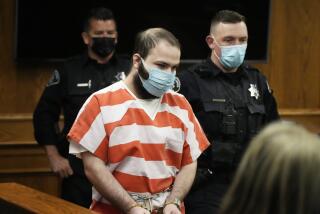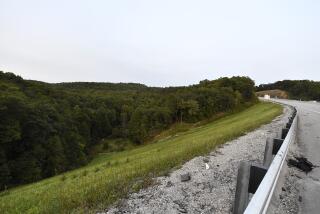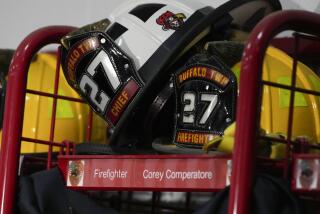Witnesses Describe the Panic After Sniper Shootings
- Share via
VIRGINIA BEACH, Va. — Death came so fast and furious on the morning of Oct. 3, 2002, that paramedic Joseph Dingle feared working in the open as he struggled to save a woman’s life.
Aware that a gun-toting killer was on the loose, the Maryland firefighter grew anxious as he and his ambulance crew approached the Shell station bay where Lori Lewis Rivera lay dying of a gunshot wound to the chest. Even a glance at a policeman unnerved him. The officer, Dingle noticed, was wearing a helmet and carrying a riot shield.
“I kind of got scared,” Dingle testified Tuesday during the murder trial of serial sniper suspect John Allen Muhammad. Without bothering to secure Rivera with straps, Dingle ordered his crew to “get this lady on a stretcher and get her back to the unit.” Safe inside the ambulance, Dingle and his crew tried to revive the unconscious woman, but quickly realized she was gone.
“There was no breathing, no pulse,” he said.
Called to the witness stand Tuesday by prosecutors, more than a dozen police officers, emergency officials and residents painted a hectic tableau of panic in the streets of Montgomery County, the Maryland suburb that shuddered as five residents were killed in a day’s time.
Witnesses at the crime scenes called in frantically. Overcome by panic, a retiree mistakenly described rifle victim Sarah Ramos as a suicide. Dispatchers pleaded for help from overtaxed officers. And invisible amid the chaos, prosecutors charged, Muhammad and his teenage accomplice, Lee Boyd Malvo, moved slowly and stealthily in the Chevrolet Caprice they had modified into a rolling sniper’s nest.
Three prosecution witnesses testified Tuesday that they noticed the Caprice and its darkly tinted windows parked near two shooting scenes. But their sightings were lost during the mounting hysteria -- either left unreported until after Muhammad’s arrest or ignored because of investigators’ mistaken obsession with witness reports of a white van.
Muhammad has been charged by Virginia authorities with the sniper-linked killing last Oct. 9 of Dean Meyers, a Maryland civil engineer gunned down at a Manassas, Va., gas station. Malvo is charged separately with the killing of FBI analyst Linda Franklin and will be tried next month.
Despite their single murder charge, prosecutors from Prince William County, Va., are trying to tie Muhammad to all 10 sniper slayings, three other homicides committed in the Deep South and seven other shootings. A Virginia law allows authorities to seek the death penalty against suspects accused of more than one killing in a three-year period -- and permits bringing in evidence of other murders to prove that charge.
Just before Ramos, 33, was killed by a rifle blast as she waited on a bus bench, makeup artist Kerry Turner glimpsed a dark blue Caprice parked nearby in a supermarket parking lot.
“It was the only car in that section of the parking lot that morning and it caught my eye,” Turner testified.
Peter D. Greenspun, Muhammad’s defense lawyer, questioned whether her sighting might have been influenced by “a lot of publicity” after the sniper suspect’s arrest.
But witnesses told of other Caprice sightings. Just after the 9 p.m. slaying of Haitian retiree Pascal Charlot -- the fifth sniper victim killed that day and the sixth in just over 24 hours -- two employees of a Jamaican restaurant watched as a dark-hued car with glazed windows drove away from the shooting scene in northwest Washington, near the Montgomery County line. The car moved slowly with its headlights off, not stopping for a stop sign.
“It creeped off just after I heard the sound” of a single gunshot, said Karl Largie, manager of the Tropicana Restaurant.
Tropicana owner Gail Howard, who also saw the slow-moving car, described it as “what I call an old police car: boxy, square, long.” When Prince William County Assistant Commonwealth Atty. Richard A. Conway showed her a photograph of the old blue Caprice owned by Muhammad, Howard nodded.
“Looks pretty much like it,” she said.
Howard said she reported the sighting to Washington police investigators the next day.
But Howard’s Caprice sighting was later forwarded by Washington Metro police officials as a dark, possibly maroon-colored vehicle -- ignored as sniper task force officials concentrated on white vans. The snipers killed four more people and wounded three others until Muhammad and Malvo were arrested a year ago on Oct. 24.
On Oct. 4, 2002, the day Howard went to police, the sniper struck again. Caroline Seawell, 44, a mother of two, was shot in the back as she loaded packages in the parking lot of the Spotsylvania Mall, a suburban stretch halfway between Washington and Richmond, Va.
On Tuesday, Seawell recalled the agonizing moment when the sniper’s bullet tore into her lower back and exploded below her chest. “First I thought, please God, don’t let me die,” Seawell said, smiling nervously.
But Seawell said she remained conscious as paramedics lifted her gently into an ambulance and treated her on the way to a Fredericksburg hospital. From there, she was airlifted by helicopter to a Fairfax hospital, where doctors stabilized her condition.
Surgery removed a large chunk of the bullet a month later. But “I still have bullet fragments inside me,” Seawell said.
More to Read
Sign up for Essential California
The most important California stories and recommendations in your inbox every morning.
You may occasionally receive promotional content from the Los Angeles Times.










